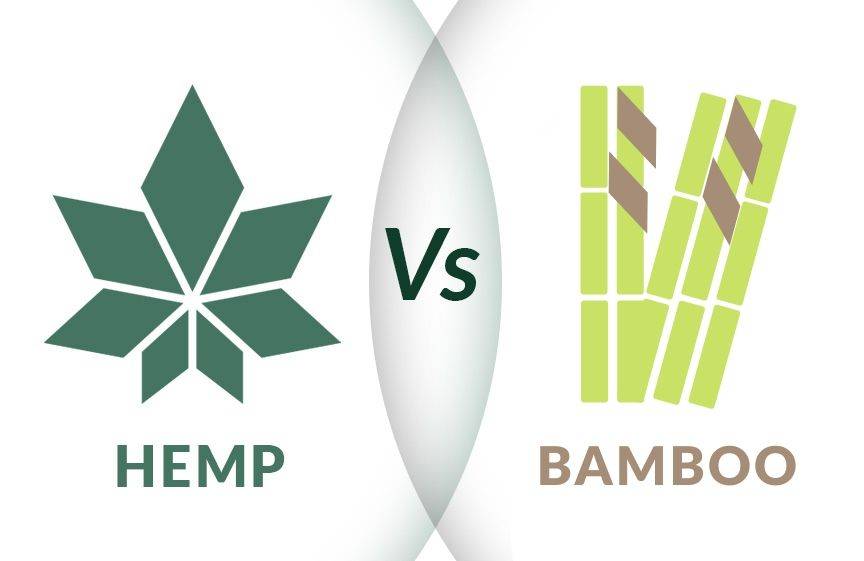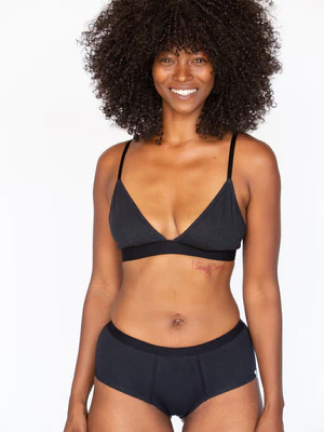
Hemp vs Bamboo: 5 Reasons Why Hemp Is More Sustainable
|
If you're not happy with your first pair of underwear after trying it on, let us know.
We'll send a new size or color, or give you a refund. No returns needed.

Katie Lemon
|
Hemp and bamboo clothing have both been lauded as champions of the sustainable fashion world. From Stella McCartney to Eileen Fisher, designers are starting to incorporate more environmentally-friendly fabrics. Which is super exciting! However, not all sustainable materials are created equally. When it comes to hemp vs cotton, you already know that hemp is the more sustainable option. But when it comes to hemp vs bamboo, there are a few important factors that may surprise you. For one, did you know that bamboo underwear does not exist?
There are a couple of reasons that hemp is more sustainable than bamboo at the cultivation stage. For one, while they both require far less water than cotton, hemp needs even less than bamboo. And even though both plants enrich the soil, growing hemp still has a major advantage over growing bamboo.
Here’s the deal: hemp is one of the best plants at ridding the environment of harmful toxins. It’s able to grow in contaminated soil without any ill effect on it’s own health, making it something of a super plant. This process is called “phytoremediation,” and hemp is so good at it that scientists successfully improved the soil in Chernobyl using hemp after the disastrous nuclear accident in 1986.
Still, there are other aspects of bamboo cultivation that are beneficial to the environment. For one, bamboo means business when it comes to rapid growth. Bamboo is one of the fastest growing plants on earth, with some varieties growing over two feet a day. And because it’s a perennial grass, bamboo also grows back quickly and easily after being harvested without needing to be uprooted.
In the battle of hemp vs bamboo, they’re almost evenly matched at the cultivation stage. But unfortunately for bamboo, it’s only downhill from here.
Beyond cultivation, hemp is far kinder to the environment than bamboo during the manufacturing process as well. Turning raw bamboo fibers into fabric is the opposite of sustainable. In fact, it’s largely been discredited as a solid alternative to cotton. This is because it takes a rigorous process to turn tough bamboo stalks into soft cloth.
The actual final result is bamboo viscose, or rayon. Here’s how the viscose process works: bamboo pulp is extracted from the plant using steam, and then mixed with toxic chemicals to break down the pulp. This mixture is then spun into fibers. The final result is bamboo viscose or rayon, which ranks dismally low on the Environmental Benchmark for Fibres.
Most producers don’t even recycle the chemicals used to make viscose. Instead, these chemicals end up polluting the environment, leaching into the air and waterways.
On the other hand, hemp is processed manually with few or no chemicals. It’s largely considered one of the most sustainable fibers available. Just peep at that ‘Class A’ column on the Environmental Benchmark for Fibres! This means that hemp is better for the environment at both the cultivation and processing stage, outranking bamboo rapidly.
While there are a variety of ways to process hemp in a way that’s sustainable for the environment and the labor force, there aren’t many safe ways to make bamboo fabric. Organizations can’t be considered sustainable if they don’t protect the health and safety of their employees. Plain and simple, bamboo viscose isn’t good for the people producing it.
This is because the various chemicals used to make viscose are toxic, which is harmful to the workers processing bamboo. Nasty side effects of producing viscose include but are not limited to cardiovascular damage, nervous system damage, and chemical burns. Yikes!
However, harmful chemicals and pollutants are not required to make hemp. It is a long hand labor process, but well-vetted manufacturers ensure safe work practices and provide jobs to many workers.
Sustainability is about so much more than just saving the environment. It’s about balancing the needs of people and the planet to ensure long-term success and lasting positive effects. So when it comes to worker safety, hemp surpasses bamboo easily.
While raw bamboo and hemp both contain antibacterial properties, bamboo doesn’t maintain those qualities after it’s processed into fabric. If you need a refresher on what it means for a fabric to be antibacterial, I’ve got you covered. Check out the handy flow chart included in our article about how antibacterial underwear works.
Now that we’ve cleared that up, let’s get into what makes hemp the more sustainable choice when it comes to fighting off harmful bacteria. First, we’ll have to look at what makes bamboo a less desirable choice.
Of course, it all comes back to that pesky viscose process. Essentially, bamboo is just being reduced to cellulose before it’s transformed into viscose, at which point many of its sustainable factors and purported benefits cease to exist. This includes it’s naturally antibacterial qualities, which disappear after being turned into cellulose pulp.
Luckily for you, hemp is not the same. Even after being processed into fabric, WAMA’s hemp underwear received exciting lab results. It was confirmed: hemp fabric is way more antimicrobial than it’s cotton counterpart.
Click Here to View Full Lab Test Report
So over time, you can get a lot more wear out of hemp clothing without having to worry about funky bacteria or microbes building up. Of course, you should still wash hemp clothing regularly. Not sure about the best way to do that? Check out our tips on how to hand wash underwear in the most sustainable way.
Bamboo fabric may be super soft, but after going through the viscose process and being blended with other materials, it’s not the most durable. Hemp is far more reliable for it’s enduring strength as a fabric.
Unlike bamboo, hemp has some of the longest and strongest natural fibers in the world. You can count on hemp clothing to really last, even with lots of wear and tear. And you don’t have to skimp on softness when it comes to hemp. It’s naturally super breathable and gets softer with every wash.
When your clothes are made from durable materials like hemp, you can stretch what you’ve got in your closet for a lot longer. This reduces your contribution to global waste, which is always more sustainable than cycling through clothes made from weak materials in a season or less.
When it comes to hemp underwear vs bamboo underwear, hemp is the far better choice if sustainability is what matters to you. You’ll get more wear out of your hemp clothing, and can sleep peacefully knowing you’re not contributing to the hazardous production of bamboo viscose. Better yet, there are so many options for hemp underwear. From hemp thongs to hemp boxers, you’re covered no matter which style you prefer.
So which fact surprised you the most? Are you ready to make the switch to hemp, and say goodbye to bamboo viscose?
Get updates on restocks, new color and size releases, and upcoming product launches. You’ll also get a 15% discount on your first order of hemp underwear.











